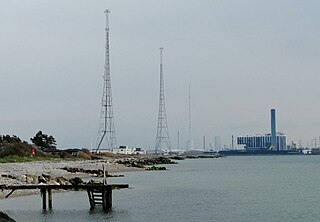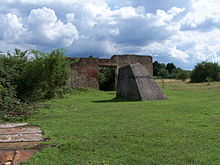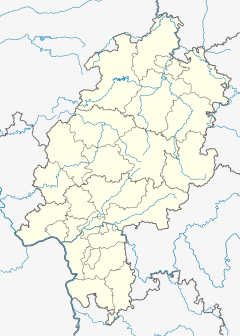
The Blosenbergturm is a former radio transmission tower built for the German-language radio station DRS at Beromünster in the Canton of Lucerne, Switzerland, in 1937. It radiated first at 529 kHz and later at 531 kHZ, the lowest officially allocated frequency in the European medium-wave band.

The Mühlacker Broadcasting Transmission Facility is a radio transmission facility near Mühlacker, Germany, first put into service on November 21, 1930. It uses two guyed steel tube masts as aerials and one guyed steel framework mast, which are insulated against ground. It has two transmission aerials for shortwave and one free standing steel framework tower for directional radio services. The shortwave transmitter was shut off on October 19, 2004. The medium wave transmitter was switched off in January 2012.

Kalundborg Radio was a major transmission facility for long- and mediumwave at the harbour of Kalundborg in Denmark. Longwave broadcasts on 243 kHz began on 27 August 1927 and ceased on 31 December 2023. Mediumwave broadcasts on 1062 kHz began on 1 October 1951 and ceased in June 2011.

The Transmitter Ismaning was a large radio transmitting station near Ismaning, Bavaria, Germany. It was inaugurated in 1932. From 1932 to 1934 this transmitter used a T-antenna as transmitting antenna, which was spun between two 115-metre-high free-standing wooden lattice towers, which were 240 metres apart. As this antenna had an unfavourable vertical radiation pattern, which produced much skywave resulting in a too small fading-free reception area at night, in 1934 a new antenna was installed. Therefore, one of the towers was dismantled and rebuilt on a 39-metre-high (128 ft) wooden lattice base. While this work took place, an L-Antenna was used, which was spun between the other tower and a small auxiliary wooden tower. It became defunct in 1977 and was destroyed in 1983.

The Wachenbrunn transmitter was a large broadcasting facility for medium wave in Wachenbrunn near Themar, Thuringia, Germany, established in the 1950s. Until 1993 the main transmitter of this facility, the medium wave transmitter for 882 kHz was run with 250 kilowatts. In that year the transmission power of this transmitter, which was formerly used for transmitting the "Voice of DDR" and since the beginning of the 1990s for "MDR info" was reduced to 20 kilowatts.

Grimeton Radio Station in southern Sweden, close to Varberg in Halland, is an early longwave transatlantic wireless telegraphy station built in 1922–1924, that has been preserved as a historical site. From the 1920s through the 1940s it was used to transmit telegram traffic by Morse code to North America and other countries, and during World War II was Sweden's only telecommunication link with the rest of the world. It is the only remaining example of an early pre-electronic radio transmitter technology called an Alexanderson alternator. It was added to the UNESCO World Heritage List in 2004, with the statement: "Grimeton Radio Station, Varberg is an exceptionally well preserved example of a type of telecommunication centre, representing the technological achievements by the early 1920s, as well as documenting the further development over some three decades." The radio station is also an anchor site for the European Route of Industrial Heritage. The transmitter is still in operational condition, and each year on a day called Alexanderson Day is started up and transmits brief Morse code test transmissions, which can be received all over Europe.

A lattice tower or truss tower is a freestanding vertical framework tower. This construction is widely used in transmission towers carrying high-voltage electric power lines, in radio masts and towers and in observation towers. Its advantage is good shear strength at a much lower weight than a tower of solid construction would have as well as lower wind resistance.

An observation deck, observation platform, or viewing platform is an elevated sightseeing platform usually situated upon a tall architectural structure, such as a skyscraper or observation tower. Observation decks are sometimes enclosed from weather, and a few may include coin-operated telescopes for viewing distant features.
The Millennium Tower is a planned skyscraper whose construction will start in 2025. When completed in 2030, it will be the European Union's second tallest building and Germany's tallest building. It will contain Germany's tallest observation deck with a panoramic view over Frankfurt. The tower will have a height of 288 m (945 ft) and 67 stories. The architect of the tower is Ferdinand Heide and the client is CA Immo.

Timber recycling or wood recycling is the process of turning waste timber into usable products. Recycling timber is a practice that was popularized in the early 1990s as issues such as deforestation and climate change prompted both timber suppliers and consumers to turn to a more sustainable timber source. Recycling timber is the environmentally friendliest form of timber production and is very common in countries such as Australia and New Zealand where supplies of old wooden structures are plentiful. Timber can be chipped down into wood chips which can be used to heat homes or generate electricity.
The Madona Radio Towers were two wooden Latvian radio towers in the town of Madona that were constructed and finished in the year 1932. The Madona radio towers were used as means of communication from 1932, the year the towers were constructed, until 1944, when it was destroyed by the invading German occupants during World War II. These two towers were also the tallest structures ever built of wood in Latvia and also the tallest wooden towers ever built with triangular cross section. The towers' antenna measured 116 metres above sea level. In addition, the tower had neither a roof nor floors.
Gross Reken Melchenberg Radio Tower, or simply the Melchenberg Radio Tower, is a German concrete radio tower that is located in the municipality of Reken, in the state of North Rhine-Westphalia. Like the Melchenberg Observation Tower, it is a lattice tower that is currently being used as means of communication. Although its construction date is unknown, it was formerly used by the military. Its antenna's height is 70 metres long.

The Gillerberg Observation Tower is a German steel lattice observation tower that was built in 1892. The Gillerberg Observation Tower is one of the oldest lattice towers in Germany and was renovated in 2004. The height of its observation deck is 15 metres above the ground.

Schomberg Observation Tower is a German observation tower that was constructed in 2005 and was finished in 2006. It is a steel truss tower that is used for observation, at the same time, used for mobile phone services. The tower is 60 meters high, including the antenna. It has an observation deck in 30 meters height.

Poppenberg Observation Tower is a steel German lattice observation tower that is used for observation, at the same time, for communication. It is a truss tower located in the summit of Poppenberg. It is one of the oldest steel lattice towers in Germany and was built in the year 1897. It was later on refurbished in 1994. The tower was built by the Nordhausen branch of the Harz Club. The tower was also named after Otto, Prince of Stolberg-Wernigerode. It has an antenna that is 33 metres long.
The Gustav Vietor Tower was one of the earliest steel lattice observation towers to be built in Germany. Constructed of stone and steel in 1882–3 on the Hohe Wurzel mountain near Wiesbaden in Hesse, the 23-metre-tall tower was demolished in 2006, having been closed to visitors 20 years earlier, although it remained in use by radio amateurs.
Utbremen Radio Tower, also known as Utbremen Transmission Tower or Utbremen Broadcast Tower, was a wooden German lattice radio tower that was mainly built for mediumwave broadcasting. The tower was built in 1933 but was destroyed six years later, in 1939, by lightning. It had an antenna that was 90 metres long.
Astara Television Tower, is a steel 243.9 m (800 ft) tall Azerbaijani lattice television tower located in the city of Astara, on the southeastern part of the Republic of Azerbaijan. The tower is used for transmitting FM Radio and TV-broadcasting as well as being used as a mobile repeater.













